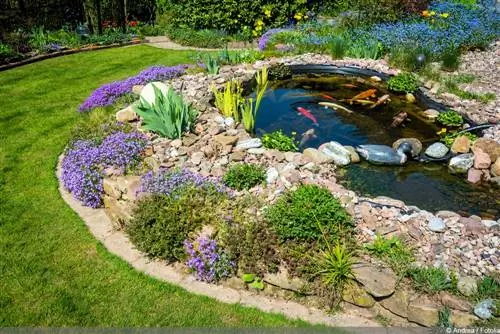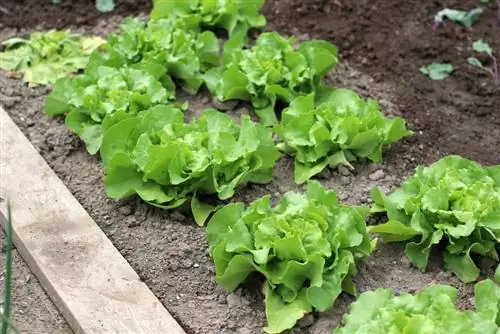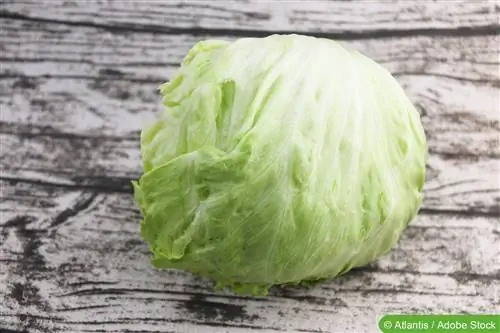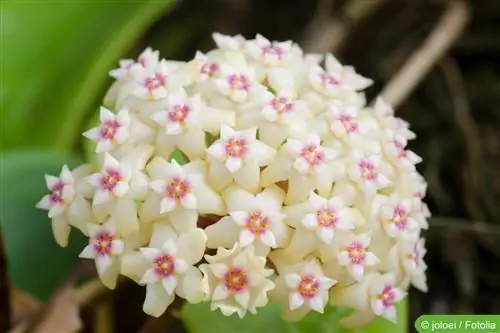- Author admin [email protected].
- Public 2023-12-17 03:39.
- Last modified 2025-01-24 12:45.
Cultivating the mussel flower is comparatively easy if you pay attention to a few points. From overwintering to locations and propagation, you will get important tips here.
Location
Water lettuce is a floating plant that comes from the tropics. It therefore needs sufficient light and heat both in the pond and in the aquarium. The plants are not affected by constant water movements. It should therefore not be used near the pump or near a stream.
Aquariums
Optimum temperatures and conditions are achieved in the aquarium if you pay attention to these factors:
- maintain sufficient distance from the aquarium lamp
- do not use near the filter
- remove excess copies
Note:
The Pistia stratiotes comes into its own especially in open aquariums that are illuminated from above from a greater distance. It also looks very decorative and does not require any special winter storage in the house. The care is then extremely easy.
Garden pond
Since the mussel flower is not hardy, it can only remain in the pond from late spring to late summer. During this time, the rosettes above the water surface are extremely decorative and provide shade. They also offer hiding places for aquatic creatures and thus protection.
Note:
Another advantage is that the plants remove nutrients from the water and can therefore displace algae, for example. However, it is also possible that they become competition for other aquatic plants.
Substrate
The water lettuce does not require any substrate or attachment as it floats freely in the water. The roots absorb nutrients directly from the liquid. They also thrive wonderfully in a small plastic garden pond.
Planting
This is extremely simple. The plants can be used in aquariums all year round. After purchase, they are simply washed carefully and then placed on the surface of the water so that the rosette faces upwards.
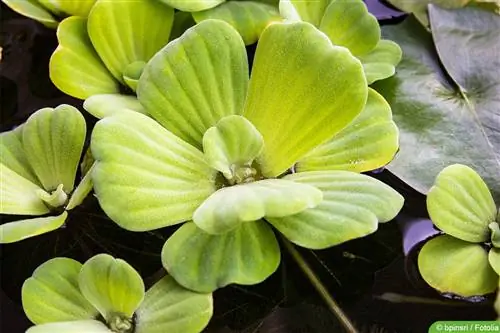
The plants are introduced into the garden pond when the water has reached a sufficiently high temperature. This means a minimum of 15 degrees Celsius, which also prevails at night.
Fertilize
Fertilization is not necessary. A layer of sludge automatically accumulates in the garden pond from fish and other aquatic creatures as well as other plants. This releases nutrients and makes further fertilizers unnecessary.
The situation is similar in aquariums. Leftover food, fish droppings and sludge between gravel or sand enrich the water with nutrients. However, there are some factors in aquariums that can reduce the nutrient content of the water. These include:
- Sucking out the debris
- Filter
- Cleaning the windows
- Partial or complete water change
Normally, however, there are enough substances in it that the plants continue to thrive without any problems. If growth slows down, you can place the shell flower in a container filled with a mixture of water and clay for a few days.
Blend
Pruning is not necessary to limit growth or maintain shape. However, there are cases when leaves should be removed. These are:
- changing plant parts
- dried sections
- withered leaves
Because when these plant shoots decompose, they can have a negative impact on the quality of the water, rot and give off a very unpleasant smell.
Propagation
Specific propagation via division, seeds or cuttings is not necessary. Since the floating plant reproduces itself via offshoots, these can easily be separated and moved if necessary.
Note:
Especially in summer and under optimal conditions, the plant grows and reproduces very quickly. This can be problematic because the plant crowds out others. If necessary, a part must be removed and disposed of to prevent this case.
Wintering
Because water lettuce is not hardy and is sensitive to temperatures below 15 degrees Celsius. If the plants are in the garden pond, they should be brought indoors as soon as the temperatures fall below this range.
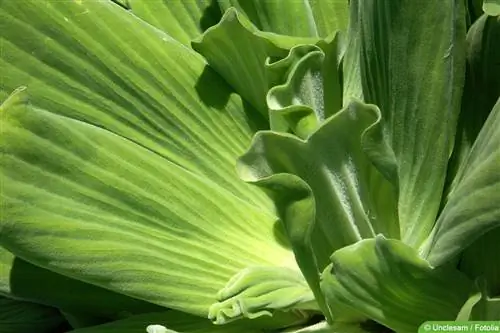
The following steps are required for successful wintering:
1. Choose the right vessel
The container must be of sufficient size, stable and easy to clean. For a small number of plants, a normal bucket is sufficient. However, if it is a larger quantity, a bricklayer's doll, for example, can be a good choice.
2. Clean plant
So that neither germs nor pests from the garden pond are introduced into the fresh water, you should rinse the plants thoroughly.
3. Remove damaged parts
Leaves and roots that show damage or discoloration are cut off with sharp and clean scissors. This way you can prevent rot.
4. Bring in clay soil
A shallow layer of clay soil is ideal for providing nutrients. Alternatively, you can also add substrate for other aquatic plants.
5. Fill with water
Now fill in enough water so that the plants can swim freely.
6. Select location
The Pistia stratiotes needs a bright location where the temperature is between 15 and 20 degrees Celsius.
Also carry out regular checks and change the water if necessary. This will prevent rot. No precautions need to be taken for wintering in aquariums.
Diseases
Isnesses are hardly to be expected with the mussel flower. Apart from rot and mold, there are currently no other known pathogens that affect Pistia stratiotes. So you don't have to expect the plant to become ill.
Pests
Similar to diseases, these do not pose a problem for the plant. Since it comes from significantly warmer regions, the local parasites are not interested in the plant.
Only fish and other aquatic creatures can harm Pistia stratiotes if they use the roots as a food source. Goldfish and koi in particular are capable of causing significant damage. However, due to the rapid reproduction of the floating plant, this is usually not a problem.
Care errors
Water lettuce is comparatively easy to care for, but unintentional errors can still occur during cultivation. Typical and therefore comparatively common are:
Wrong temperature
Temperatures that are too low can quickly destroy the plants. Late frost, protection that is too late in autumn or overwintering that is too cold are devastating care mistakes.
Lack of nutrients
Too few or too many nutrients in the water can significantly restrict growth and lead to the death of the aquatic plant.
Missing waste
If withered plant sections are left on the mussel flower, they not only pose a danger to the plant itself, but also to the water quality and living creatures in garden ponds or aquariums. Because the water can literally turn into manure. Characteristic notes are:
- brown discoloration of the water
- intense, foul smell
- almost oily film on the water surface
Carp-like fish such as goldfish and koi feed, among other things, on the roots of water lettuce. However, if the number of animals is too large, it can happen that they become too short and can no longer absorb sufficient nutrients from the water. Possible solutions are:
- to reduce the stocking
- feed the fish more
- remove the plants from the pond until the roots regenerate
Too little light
The Pistia stratiotes gets too little light just as much as the temperature is too low. Very shady locations or overwintering that is too dark are therefore harmful. If there is no suitable room for overwintering, the plant can also survive in the basement or a dark room. But this only applies as long as a plant light is used.
More errors
- Errors during wintering
- Oversupply of nutrients
- destroyed roots by fish
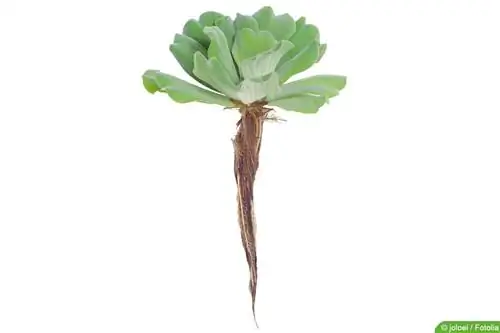
Edible
The mussel flower belongs to the arum family and is therefore not only inedible to humans, but poisonous. However, it does not pose a problem for fish and other aquatic creatures. Despite the name water lettuce, the floating plant isnot edible.
Ban
In 2018, it was discussed whether a ban on water lettuce would make sense. Because it is a plant that is not native to our latitudes and it can spread very invasively. The danger is that native plants will be displaced as a result. However, the ban has not yet been enforced.
Flowering time
The shell flower blooms between June and September. If you want to recognize the flowers, you have to look very closely. They are extremely inconspicuous and can be found in the middle of the rosettes.


